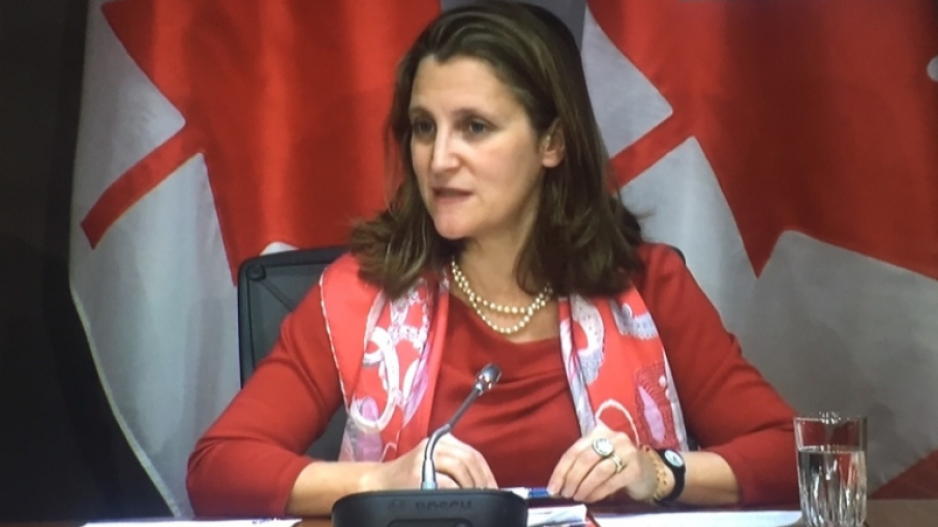
In her budget speech, Freeland said, “our ability to spend is not infinite. The time for extraordinary covid support is over. And we will review and reduce government spending, because that is the responsible thing to do.”
As expected, Freeland’s budget focuses some of the new spending in three key areas: fighting climate change, housing, and defence. The additional defence spending is a kind of last-minute add-on resulting from the war in Ukraine, which has highlighted Canada’s obligations as a member of NATO.
The deficit for 2022-23 is projected to be C$52.8 billion, which is lower than the C$144 billion projected in the last fiscal update. Revenue from high commodity prices, particularly oil, gives Freeland more room to spend without resorting to higher deficit spending. The budget contains about C$60 billion in new spending.
“While debt and deficits remain high, new spending was more modest than predicted,” the Greater Vancouver Board of Trade notes. “The most significant improvement in the fiscal circumstance came from C$90 billion in higher-than-anticipated revenues, primarily corporate and personal income taxes, due to an improved economic outlook.
“In an encouraging sign, federal debt-to-GDP is projected to decline throughout the forecast from 46.5% to 41.5% by 2026-27. While the federal government’s books appear to have improved, businesses’ balance sheets will continue to be challenged by inflation and rising costs.”
The budget targets big banks and insurance companies with a new tax on the profits made throughout the pandemic. It includes a one-time 15% surtax on taxable income over C$1 billion for the 2021 tax year, plus a permanent increase of 1.5% to the corporate tax rate for banks and insurance companies.
Small businesses catch a break, however, especially those that are growing. Small businesses pay a lower corporate tax rate of 9%, but the regular rate of 15% kicks in once their taxable capital hits C$15 million. To avoid discouraging small businesses from growing, the government will boost that threshold to $50 million.
New spending includes C$3.8 billion to implement Canada’s first Critical Minerals Strategy, aimed at securing domestic supplies of nickel, copper, cobalt, rare earths and uranium.
“For guys in this town and the mining community, that’s going to matter,” said Bruce Sprague, Western Canada Tax Service Leader for BDO. “I suspect there’s guys in some of these towers that are pretty enthusiastic about these measures.”
“With today’s budget, the Government of Canada has positioned Canada in a leading competitive position for new investments up and down the minerals and metals sector and beyond,”said Pierre Gratton, president of the Mining Association of Canada. “Doubtless, these measures will give Canada a lock on the top spot for global exploration investment and spur new investments across the value chain,”
As part of the government’s goal of reducing greenhouse gas emissions in the oil and gas sector, the budget includes a new investment tax credit to encourage investment in carbon capture and storage in the oil and gas sector, valued at C$2.6 billion over five years. The new tax credit for CCS grants a 37.5% to 60% tax break on the purchase of eligible equipment. Meanwhile, the government is eliminating flow through shares for oil and gas sector investments.
Freeland said the budget has funding to double the number of new homes built in Canada. It also includes a new measure to ban foreign investment in Canadian residential real estate, and goes after real estate speculators.
“Budget 2022 proposes to introduce new rules so that any person who sells a property they have held for less than 12 months would be subject to full taxation on their profits as business income,” the budget states.
For new homeowners, there is a new tax-free first home savings account that allows first-time home buyers to save up to C$40,000 towards a down payment on a new home.
New spending includes:
- C$4 billion over five years for a new Housing Accelerator Fund to build 100,000 new housing units;
- C$5.3 billion over five years for a new dental program for low-income Canadians;
- C$8 billion for defence over five years, including contributions to NORAD and cybersecurity;
- C$1 billion over five years for a new federal innovation and investment fund aimed at leveraging private sector investment in Canada
On climate change, the recently released 2030 Emissions Reduction Plan earmarks C$9 billion in investments and subsidies, but it’s not clear from the budget documents if all of that is funded in the 2022 budget. It does include C$1.7 billion over five years for subsidies for zero emission vehicles.
Budget 2022 forecasts lower GDP growth in 2022 compared to 2021, which was 4.6%. The last fiscal update had forecast 4.2% GDP growth in 2022. Budget 2022 revises that to 3.9%.
(This article first appeared in Business in Vancouver)




